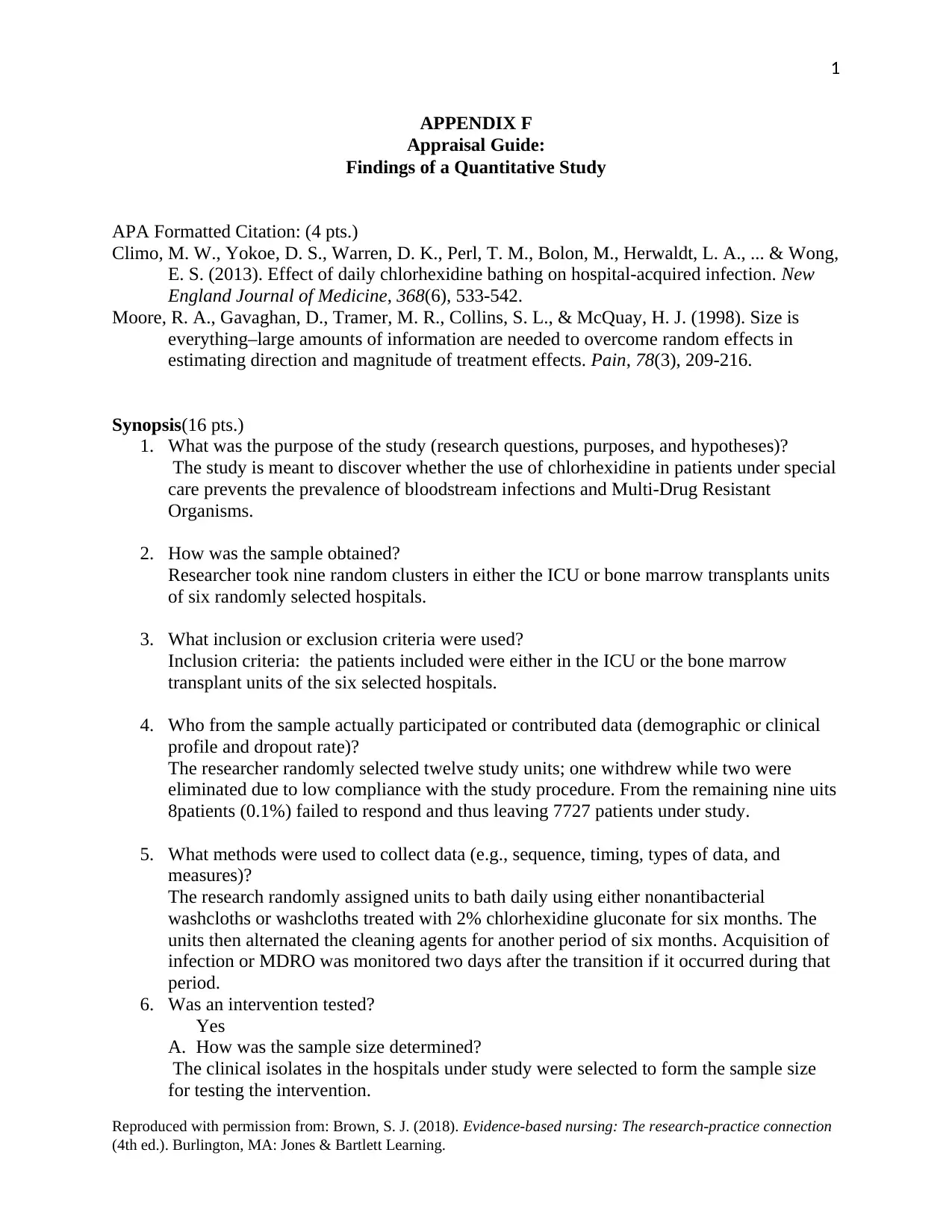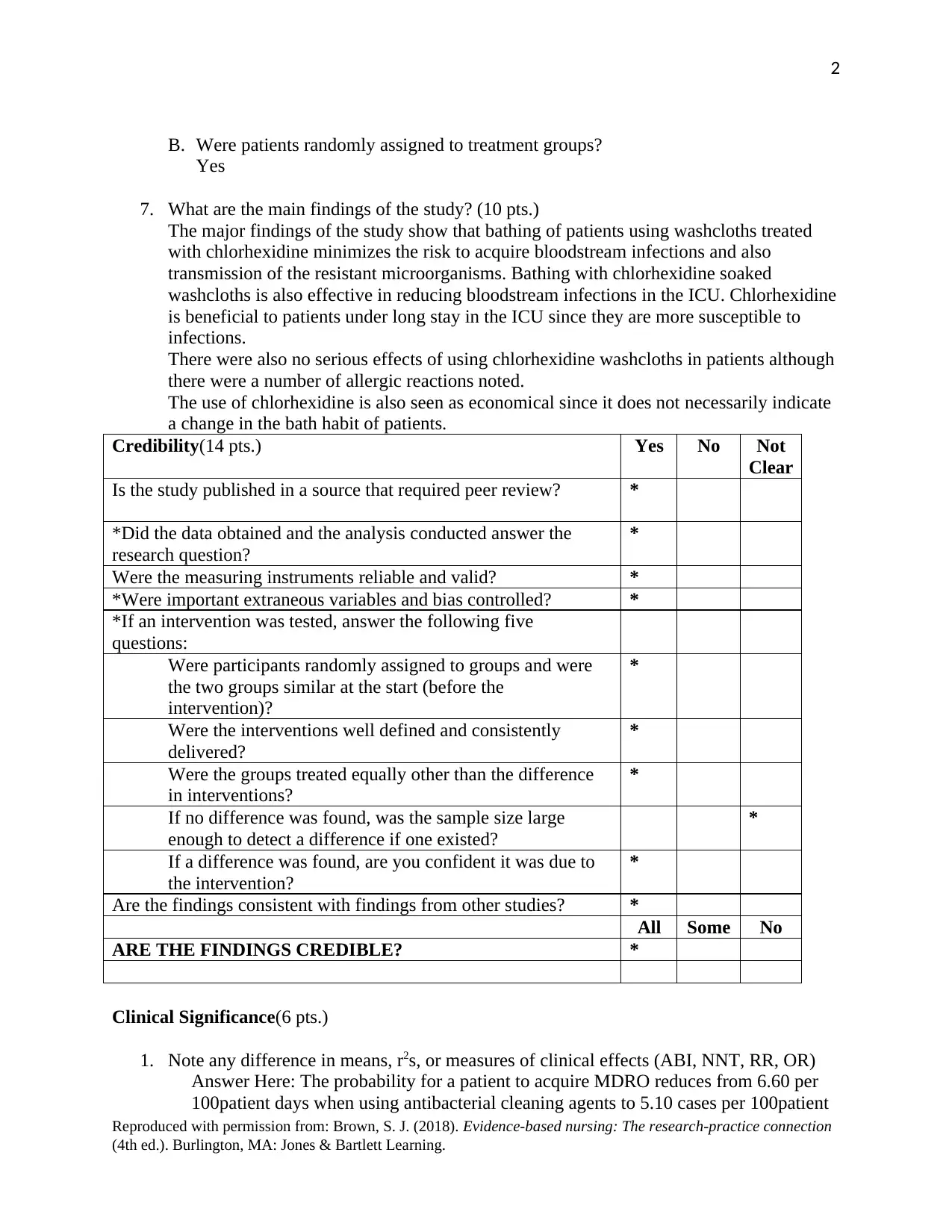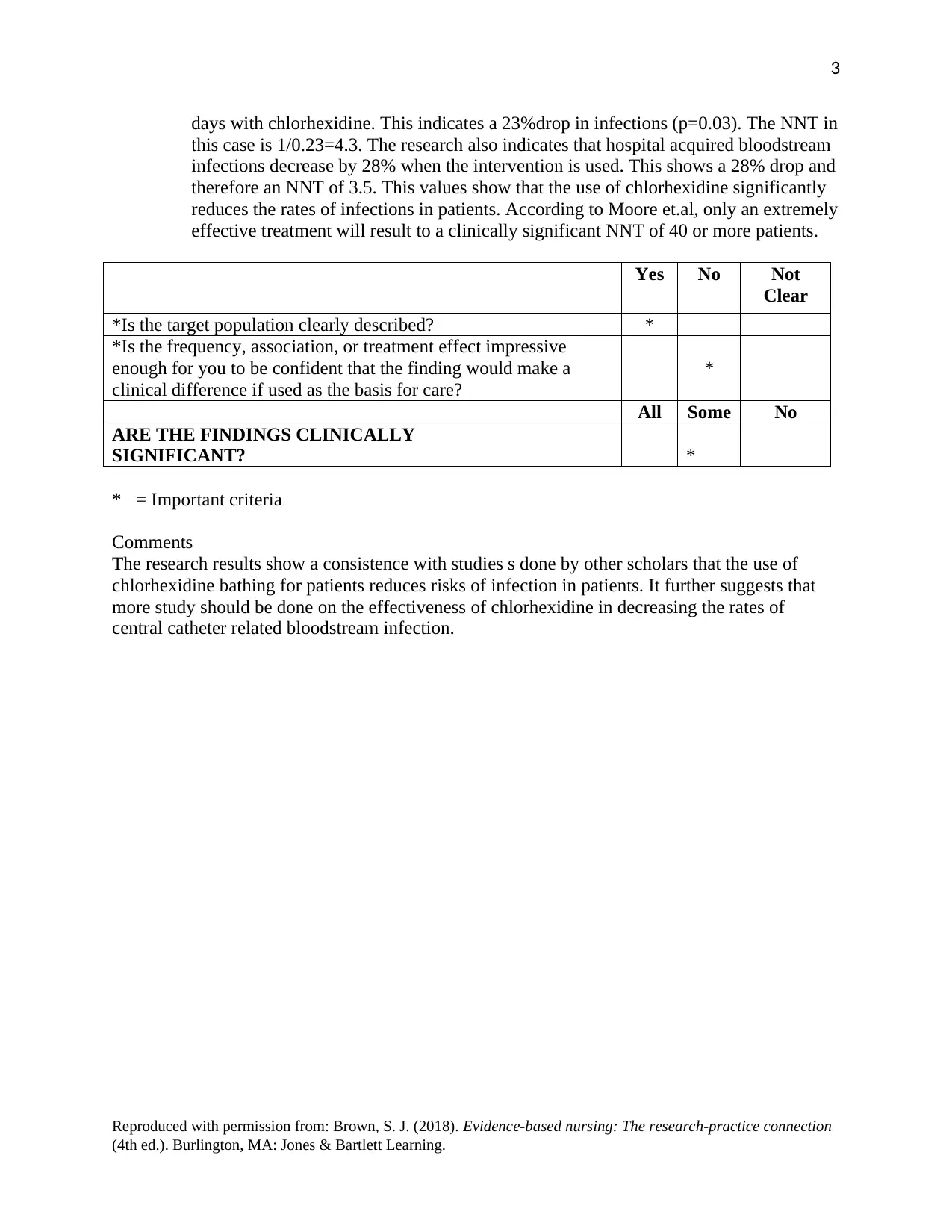Quantitative Study Appraisal Guide: Findings of Research
VerifiedAdded on 2020/05/16
|3
|1025
|146
Homework Assignment
AI Summary
This assignment is an appraisal guide for a quantitative study, specifically focusing on the research by Climo et al. (2013) regarding the effect of daily chlorhexidine bathing on hospital-acquired infections. The appraisal covers several aspects of the study, including its purpose, methodology, sample selection, data collection methods, and the intervention tested. It examines the study's findings, such as the reduction in bloodstream infections and MDROs, and evaluates their credibility and clinical significance, including the calculation of NNT values. The appraisal also assesses the study's strengths, weaknesses, and consistency with other research findings, offering a comprehensive analysis of the study's impact and implications in healthcare. The analysis includes the study's strengths, weaknesses, and the reliability of the findings.

APPENDIX F
Appraisal Guide:
Findings of a Quantitative Study
APA Formatted Citation: (4 pts.)
Climo, M. W., Yokoe, D. S., Warren, D. K., Perl, T. M., Bolon, M., Herwaldt, L. A., ... & Wong,
E. S. (2013). Effect of daily chlorhexidine bathing on hospital-acquired infection. New
England Journal of Medicine, 368(6), 533-542.
Moore, R. A., Gavaghan, D., Tramer, M. R., Collins, S. L., & McQuay, H. J. (1998). Size is
everything–large amounts of information are needed to overcome random effects in
estimating direction and magnitude of treatment effects. Pain, 78(3), 209-216.
Synopsis(16 pts.)
1. What was the purpose of the study (research questions, purposes, and hypotheses)?
The study is meant to discover whether the use of chlorhexidine in patients under special
care prevents the prevalence of bloodstream infections and Multi-Drug Resistant
Organisms.
2. How was the sample obtained?
Researcher took nine random clusters in either the ICU or bone marrow transplants units
of six randomly selected hospitals.
3. What inclusion or exclusion criteria were used?
Inclusion criteria: the patients included were either in the ICU or the bone marrow
transplant units of the six selected hospitals.
4. Who from the sample actually participated or contributed data (demographic or clinical
profile and dropout rate)?
The researcher randomly selected twelve study units; one withdrew while two were
eliminated due to low compliance with the study procedure. From the remaining nine uits
8patients (0.1%) failed to respond and thus leaving 7727 patients under study.
5. What methods were used to collect data (e.g., sequence, timing, types of data, and
measures)?
The research randomly assigned units to bath daily using either nonantibacterial
washcloths or washcloths treated with 2% chlorhexidine gluconate for six months. The
units then alternated the cleaning agents for another period of six months. Acquisition of
infection or MDRO was monitored two days after the transition if it occurred during that
period.
6. Was an intervention tested?
Yes
A. How was the sample size determined?
The clinical isolates in the hospitals under study were selected to form the sample size
for testing the intervention.
Reproduced with permission from: Brown, S. J. (2018). Evidence-based nursing: The research-practice connection
(4th ed.). Burlington, MA: Jones & Bartlett Learning.
1
Appraisal Guide:
Findings of a Quantitative Study
APA Formatted Citation: (4 pts.)
Climo, M. W., Yokoe, D. S., Warren, D. K., Perl, T. M., Bolon, M., Herwaldt, L. A., ... & Wong,
E. S. (2013). Effect of daily chlorhexidine bathing on hospital-acquired infection. New
England Journal of Medicine, 368(6), 533-542.
Moore, R. A., Gavaghan, D., Tramer, M. R., Collins, S. L., & McQuay, H. J. (1998). Size is
everything–large amounts of information are needed to overcome random effects in
estimating direction and magnitude of treatment effects. Pain, 78(3), 209-216.
Synopsis(16 pts.)
1. What was the purpose of the study (research questions, purposes, and hypotheses)?
The study is meant to discover whether the use of chlorhexidine in patients under special
care prevents the prevalence of bloodstream infections and Multi-Drug Resistant
Organisms.
2. How was the sample obtained?
Researcher took nine random clusters in either the ICU or bone marrow transplants units
of six randomly selected hospitals.
3. What inclusion or exclusion criteria were used?
Inclusion criteria: the patients included were either in the ICU or the bone marrow
transplant units of the six selected hospitals.
4. Who from the sample actually participated or contributed data (demographic or clinical
profile and dropout rate)?
The researcher randomly selected twelve study units; one withdrew while two were
eliminated due to low compliance with the study procedure. From the remaining nine uits
8patients (0.1%) failed to respond and thus leaving 7727 patients under study.
5. What methods were used to collect data (e.g., sequence, timing, types of data, and
measures)?
The research randomly assigned units to bath daily using either nonantibacterial
washcloths or washcloths treated with 2% chlorhexidine gluconate for six months. The
units then alternated the cleaning agents for another period of six months. Acquisition of
infection or MDRO was monitored two days after the transition if it occurred during that
period.
6. Was an intervention tested?
Yes
A. How was the sample size determined?
The clinical isolates in the hospitals under study were selected to form the sample size
for testing the intervention.
Reproduced with permission from: Brown, S. J. (2018). Evidence-based nursing: The research-practice connection
(4th ed.). Burlington, MA: Jones & Bartlett Learning.
1
Paraphrase This Document
Need a fresh take? Get an instant paraphrase of this document with our AI Paraphraser

B. Were patients randomly assigned to treatment groups?
Yes
7. What are the main findings of the study? (10 pts.)
The major findings of the study show that bathing of patients using washcloths treated
with chlorhexidine minimizes the risk to acquire bloodstream infections and also
transmission of the resistant microorganisms. Bathing with chlorhexidine soaked
washcloths is also effective in reducing bloodstream infections in the ICU. Chlorhexidine
is beneficial to patients under long stay in the ICU since they are more susceptible to
infections.
There were also no serious effects of using chlorhexidine washcloths in patients although
there were a number of allergic reactions noted.
The use of chlorhexidine is also seen as economical since it does not necessarily indicate
a change in the bath habit of patients.
Credibility(14 pts.) Yes No Not
Clear
Is the study published in a source that required peer review? *
*Did the data obtained and the analysis conducted answer the
research question?
*
Were the measuring instruments reliable and valid? *
*Were important extraneous variables and bias controlled? *
*If an intervention was tested, answer the following five
questions:
Were participants randomly assigned to groups and were
the two groups similar at the start (before the
intervention)?
*
Were the interventions well defined and consistently
delivered?
*
Were the groups treated equally other than the difference
in interventions?
*
If no difference was found, was the sample size large
enough to detect a difference if one existed?
*
If a difference was found, are you confident it was due to
the intervention?
*
Are the findings consistent with findings from other studies? *
All Some No
ARE THE FINDINGS CREDIBLE? *
Clinical Significance(6 pts.)
1. Note any difference in means, r2s, or measures of clinical effects (ABI, NNT, RR, OR)
Answer Here: The probability for a patient to acquire MDRO reduces from 6.60 per
100patient days when using antibacterial cleaning agents to 5.10 cases per 100patient
Reproduced with permission from: Brown, S. J. (2018). Evidence-based nursing: The research-practice connection
(4th ed.). Burlington, MA: Jones & Bartlett Learning.
2
Yes
7. What are the main findings of the study? (10 pts.)
The major findings of the study show that bathing of patients using washcloths treated
with chlorhexidine minimizes the risk to acquire bloodstream infections and also
transmission of the resistant microorganisms. Bathing with chlorhexidine soaked
washcloths is also effective in reducing bloodstream infections in the ICU. Chlorhexidine
is beneficial to patients under long stay in the ICU since they are more susceptible to
infections.
There were also no serious effects of using chlorhexidine washcloths in patients although
there were a number of allergic reactions noted.
The use of chlorhexidine is also seen as economical since it does not necessarily indicate
a change in the bath habit of patients.
Credibility(14 pts.) Yes No Not
Clear
Is the study published in a source that required peer review? *
*Did the data obtained and the analysis conducted answer the
research question?
*
Were the measuring instruments reliable and valid? *
*Were important extraneous variables and bias controlled? *
*If an intervention was tested, answer the following five
questions:
Were participants randomly assigned to groups and were
the two groups similar at the start (before the
intervention)?
*
Were the interventions well defined and consistently
delivered?
*
Were the groups treated equally other than the difference
in interventions?
*
If no difference was found, was the sample size large
enough to detect a difference if one existed?
*
If a difference was found, are you confident it was due to
the intervention?
*
Are the findings consistent with findings from other studies? *
All Some No
ARE THE FINDINGS CREDIBLE? *
Clinical Significance(6 pts.)
1. Note any difference in means, r2s, or measures of clinical effects (ABI, NNT, RR, OR)
Answer Here: The probability for a patient to acquire MDRO reduces from 6.60 per
100patient days when using antibacterial cleaning agents to 5.10 cases per 100patient
Reproduced with permission from: Brown, S. J. (2018). Evidence-based nursing: The research-practice connection
(4th ed.). Burlington, MA: Jones & Bartlett Learning.
2

days with chlorhexidine. This indicates a 23%drop in infections (p=0.03). The NNT in
this case is 1/0.23=4.3. The research also indicates that hospital acquired bloodstream
infections decrease by 28% when the intervention is used. This shows a 28% drop and
therefore an NNT of 3.5. This values show that the use of chlorhexidine significantly
reduces the rates of infections in patients. According to Moore et.al, only an extremely
effective treatment will result to a clinically significant NNT of 40 or more patients.
Yes No Not
Clear
*Is the target population clearly described? *
*Is the frequency, association, or treatment effect impressive
enough for you to be confident that the finding would make a
clinical difference if used as the basis for care?
*
All Some No
ARE THE FINDINGS CLINICALLY
SIGNIFICANT? *
*= Important criteria
Comments
The research results show a consistence with studies s done by other scholars that the use of
chlorhexidine bathing for patients reduces risks of infection in patients. It further suggests that
more study should be done on the effectiveness of chlorhexidine in decreasing the rates of
central catheter related bloodstream infection.
Reproduced with permission from: Brown, S. J. (2018). Evidence-based nursing: The research-practice connection
(4th ed.). Burlington, MA: Jones & Bartlett Learning.
3
this case is 1/0.23=4.3. The research also indicates that hospital acquired bloodstream
infections decrease by 28% when the intervention is used. This shows a 28% drop and
therefore an NNT of 3.5. This values show that the use of chlorhexidine significantly
reduces the rates of infections in patients. According to Moore et.al, only an extremely
effective treatment will result to a clinically significant NNT of 40 or more patients.
Yes No Not
Clear
*Is the target population clearly described? *
*Is the frequency, association, or treatment effect impressive
enough for you to be confident that the finding would make a
clinical difference if used as the basis for care?
*
All Some No
ARE THE FINDINGS CLINICALLY
SIGNIFICANT? *
*= Important criteria
Comments
The research results show a consistence with studies s done by other scholars that the use of
chlorhexidine bathing for patients reduces risks of infection in patients. It further suggests that
more study should be done on the effectiveness of chlorhexidine in decreasing the rates of
central catheter related bloodstream infection.
Reproduced with permission from: Brown, S. J. (2018). Evidence-based nursing: The research-practice connection
(4th ed.). Burlington, MA: Jones & Bartlett Learning.
3
⊘ This is a preview!⊘
Do you want full access?
Subscribe today to unlock all pages.

Trusted by 1+ million students worldwide
1 out of 3
Related Documents
Your All-in-One AI-Powered Toolkit for Academic Success.
+13062052269
info@desklib.com
Available 24*7 on WhatsApp / Email
![[object Object]](/_next/static/media/star-bottom.7253800d.svg)
Unlock your academic potential
Copyright © 2020–2025 A2Z Services. All Rights Reserved. Developed and managed by ZUCOL.




